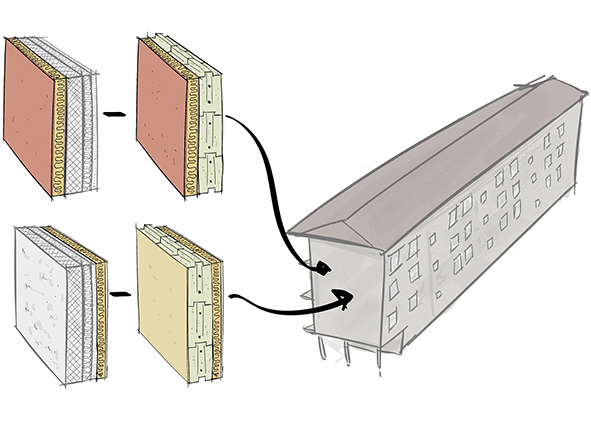Adaptive design strategies for buildings’ retrofit in response to climate change
DOI:
https://doi.org/10.19229/2464-9309/6182019Keywords:
climate change, computational design, environmental design, evolutionary solving, adaptive approachAbstract
The urban temperature raising related to climate change on-going phenomenons as a consequence of greenhouse gas concentration’s increasing, the performance flaws of Italian construction, particularly of the one built between ‘70s and ‘90s, the technological progress of technical solutions and research in the field of architecture-related digital technology, have stimulated the development of a methodology based on computational design and data exchange IT tools for buildings’ energy simulation and the definition of interventions of energy and technology retrofit aimed towards adaption and mitigation according to climatic scenarios. This contribution is focused on the experimentation of a simulative approach, based on the use of parametric software for outlining interventions of energy and technology retrofit for buildings, through a methodology replicable for urban and building regeneration actions for mitigation and climate adaption.
Downloads
Article Metrics Graph
References
Ambrosini, L., Bassolino, E. and Scarpati, F. (2018), “Thermal-Perception-Driven Adaptive Design for Wellbeing in Outdoor Public Spaces: Case Studies in Naples”, in Aletta, F. and Xiao, J. (eds), Handbook of Research on Perception-Driven Approaches to Urban Assessment and Design, IGI Global, Hershey, New York, pp. 207-239. [Online] Available at: www.igi-global.com/chapter/thermal-perception-driven-adaptive-design-for-wellbeing-in-outdoor-public-spaces/198163 [Accessed 31 October 2019].
Ascione, P. and Bellomo, M. (2012), Retrofit per la residenza – Tecnologie per la riqualificazione del patrimonio edilizio in Campania, Clean Edizioni, Napoli.
Bianchi, R. (1986), Le tecniche esecutive nell’edilizia residenziale degli anni ‘80 – Dal tradizionale evoluto al cosiddetto industrializzato, Franco Angeli, Milano.
CCIAA di Napoli and ACEN / Commissione RIT (2014), Tipologie edilizie prezzario il prezzario per tipologie edilizie di Napoli e Provincia, ACEN. [Online] Available at: docplayer.it/15799306-Tipologie-edilizie-prezzario-il-prezzario-per-tipologie-edilizie-di-napoli-e-provincia.html [Accessed 31 October 2019].
Civiero, P. (2017), Tecnologie per la riqualificazione – Soluzioni e strategie per la trasformazione intelligente del comparto abitativo esistente, Maggioli Editore, Santarcangelo di Romagna.
Corsi, E. and Frano, C. (1991), Dal Terremoto al futuro – La ricostruzione a Napoli – Il titolo VIII della Legge 219/81, Electa, Napoli.
EEA (2009), Ensuring Quality of Life in Europe’s Cities and Towns – Tackling the environmental challenges driven by European and global change – EEA Report no. 5/2009, European Environment Agency, Copenaghen. [Online] Available at: eprints.uwe.ac.uk/13151/1/Quality_of_life_in_cities%5B1%5D.pdf [Accessed 31 October 2019].
Fanger, P. O. (1972), Thermal Comfort – Analysis and Application in Environmental Engineering, McGraw-Hill Book Company, New York.
IPCC – Intergovernmental Panel on Climate Change (2018), Global Warming of 1.5 °C – Summary for Policymakers, IPCC, Switzerland. [Online] Available at: report.ipcc.ch/sr15/pdf/sr15_spm_final.pdf [Accessed 31 October 2019].
IPCC – Intergovernmental Panel on Climate Change (2015), Climate Change 2014 – Synthesis Report, IPCC, Geneva. [Online] Available at: www.ipcc.ch/site/assets/uploads/2018/05/SYR_AR5_FINAL_full_wcover.pdf [Accessed 31 October 2019].
Losasso, M. (2016), “Technological and environmental aid for the knowledge of urban districts”, in D’Ambrosio, V. and Leone, M. F. (eds), Environmental design for climate adaption – 1. Innovative Models for the production of knowledge, Clean Edizioni, Napoli, pp. 92-111. [Online] Available at: www.sitda.net/downloads/biblioteca/Environmental%20Design% 20for%20Climate%20Change%20adaptation.%201.%20Innovative% 20models%20for%20the%20production%20of%20knowledge.pdf [Accessed 31 October 2019].
Muratore, G., Capuano, A., Garofalo, F. and Pellegrini, E. (1988), Guida all’architettura moderna: Italia – Gli ultimi trent’anni, Nicola Zanichelli Editore, Bologna.
Peng, C. and Elwan S. (2014), “An outdoor-indoor coupled simulation framework for Climate Change-conscious Urban Neighbourhood Design”, in Simulation, vol. 90, issue 8, pp. 874-891. [Online] Available at: doi.org/10.1177/0037549714526293 [Accessed 31 October 2019].
Tedeschi, A. (2014), Algorithms-aided design – Parametric strategies using Grasshopper®, La Penseur Publisher, Napoli.
Troup, L. and Fannon, D. (2016), “Morphing climate data to simulate building energy consumption”, in Proceedings of SimBuild 2016 – Building Performance Modelling Conference, Salt Lake City, August 8-12 2016, ASHRAE and IBPSA-USA. [Online] Available at: ibpsa-usa.org/index.php/ibpusa/article/view/390/376 [Accessed 31 October 2019].
Tucci, F. (2018), Costruire e Abitare Green – Approcci, Strategie, Sperimentazioni per una Progettazione Tecnologica Ambientale | Green Building and Dwelling – Approaches, Strategies, Experimentation for an Environmental Technological Design, Altralinea Edizioni, Firenze.
UNI (2006), UNI EN ISO 7730:2006 – Ergonomia degli ambienti termici – Determinazione analitica e interpretazione del benessere termico mediante il calcolo degli indici PMV e PPD e dei criteri di benessere termico locale, UNI Ente Italiano di Normazione.
UNI (1997), UNI-EN-ISO 7730:1997 – Ambienti termici moderati – Determinazione degli indici PMV e PPD e specifica delle condizioni di benessere termico, UNI Ente Italiano di Normazione.
UNI (1981), UNI 8290-1:1981 + A122:1983 – Edilizia residenziale – Sistema tecnologico – Classificazione e terminologia, UNI Ente Italiano di Normazione.

Downloads
Published
How to Cite
Issue
Section
License
This Journal is published under Creative Commons Attribution Licence 4.0 (CC-BY).
License scheme | Legal code
This License allows anyone to:
Share: copy and redistribute the material in any medium or format.
Adapt: remix, transform, and build upon the material for any purpose, even commercially.
Under the following terms
Attribution: Users must give appropriate credit, provide a link to the license, and indicate if changes were made; users may do so in any reasonable manner, but not in any way that suggests the licensor endorses them or their use.
No additional restrictions: Users may not apply legal terms or technological measures that legally restrict others from doing anything the license permits.
Notices
Users do not have to comply with the license for elements of the material in the public domain or where your use is permitted by an applicable exception or limitation.
No warranties are given. The license may not give users all of the permissions necessary for their intended use. For example, other rights such as publicity, privacy, or moral rights may limit how you use the material.


















































































